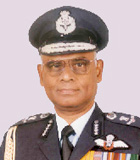INDIAN ARMED FORCES CHIEFS ON
OUR RELENTLESS AND FOCUSED PUBLISHING EFFORTS

SP Guide Publications puts forth a well compiled articulation of issues, pursuits and accomplishments of the Indian Army, over the years

I am confident that SP Guide Publications would continue to inform, inspire and influence.

My compliments to SP Guide Publications for informative and credible reportage on contemporary aerospace issues over the past six decades.
Rafale: Induction of a New Generation in War-Fighting
Induction of Rafale Jets signifies a great trust and responsibility being imposed on those who will manage, maintain, support and fly these wonderful war-fighting machines
 | By Air Chief Marshal S. Krishnaswamy (Retd) Former Chief of the Air Staff, IAF |
Combat aircraft are primarily weapons of war and their potentials define their ability in war-fighting. In 1965, our pilots fought air battles flying the Gnat that had just two guns but no missiles or on-board radar which is unthinkable these days. The MiG-21s that we acquired in the late ‘60s and right through the ‘80s flew much faster, had a rudimentary radar’ but were limited in respect of payload and range.
A void was felt in the capability of the Indian Air Force (IAF) to strike deep inside the enemy territory. That called for the induction of a fleet of Deep Penetration Strike Aircraft (DPSA) that could carry twice the load of the MiGs and fly double the range. The Jaguar came in 1979 as the DPSA which had an inertial navigation system, the accuracy of which was hitherto unheard of. These aircraft could deliver weapons with pin-point accuracy; but were limited in manoeuvrability. Then came, the air-superiority fighters that were designed with relaxed stability to achieve supermanoeuvrability by virtue of electronically-driven flight controls.
Air superiority fighters such as the F-16, Mirage 2000 and MiG-29, ruled the skies over the earlier generation of combat aircraft. Further advances in aerodynamics, lighter alloys and composite material, helped in developing fighters capable of carrying more fuel and payload without losing out on super-manoeuvrability. These were the Su-30 family of aircraft, the Eurofighter and the French Rafale. American fighters such as the F-22 and F-35 had added capabilities like Stealth that made them fifth–generation fighters. Most of these aircraft are capable of performing ‘Swing Role’ whilst in the air on a strike mission, to be swung to perform air superiority and have the extraordinary ability to cruise at supersonic speeds without sustained use of engine after-burners.

The Rafale jets of the IAF can carry a weapon load twice that of the Jaguar, covering a much farther range and yet performing effectively the role of a nimble air superiority fighter. The French have proved admirable in pursuing research in high-end technologies independently and succeeded in developing a variety of products of their own brand in a highly competitive area of aerospace engineering. Their success reflects fine leadership, cohesion of their military and scientific community as well as strong governmental support. Besides the airframe and engine, the French also developed the entire range of sensors and Electronic Warfare (EW) systems and have integrated these, right at the design stage.
We must not forget that the Project Development Phase of the Light Combat Aircraft was actively supported by the French exploiting their experience in developing the Mirage 2000. We could certainly try and emulate the French leadership and cohesion in developing our own aircraft and weapon systems.
It was a joy to see the first five Rafale Jets land so gracefully on the runway at Ambala. Hats-off to all those, who persevered for years, to get the Rafale inducted into the IAF. These Jets entering our own hangars signifies a great trust and responsibility being imposed on those who will manage, maintain, support and fly these wonderful war-fighting machines that will soon join the other protectors of our nation – and touch the sky with glory!





